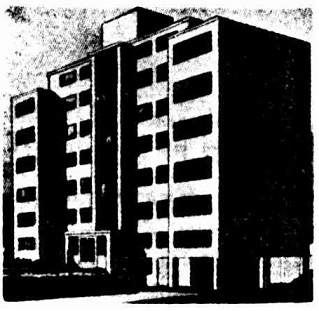Countless
Australian-born architects sought professional experience in the United
Kingdom during the 1930s; some, such as Rae Featherstone and Best
Overend, stayed for several years while others, such as Raymond McGrath
and J Kirkland Robertson, even remained there permanently. Dennis
Mirams, however, represents the far more unusual case of a British-born
architect who travelled to Australia.
Born in London in 1904, Dennis George Mirams studied architecture at London University's Bartlett School of Architecture, where he completed his Diploma of Architecture between 1922 and 1927. During 1927, he gained experience in the office of Sir Herbert Baker (1862-1946), who was then working on a major (and controversial) scheme to rebuild the headquarters of the Bank of England. In 1928, Mirams travelled to China, where he spent the next decade working as an assistant architect to the Shanghai Municipal Council. During this time, he developed an interest in traditional Chinese building that culminated in 1940 when he published a slim volume, simply entitled A Brief History of Chinese Architecture, which remains a classic introductory text to this day. In 1938, Mirams left the Shanghai Municipal Council to work as an architect and property manager for Jardine Matheson & Company, a prominent and long-established English trading firm based in Hong Kong. When Hong Kong became occupied by the Japanese during the latter years of the Second World War, Mirams was interred as an enemy alien. Released in 1945, he resumed his employment with Jardine Matheson, where he remained for another two years.
Mirams and his wife had migrated to Australia by February 1948, when he applied for registration as an architect in Victoria. As he had already qualified as an ARIBA (Associate of the Royal Institute of British Architects), Mirams was promptly bestowed with its Australian counterpart, the ARAIA, in May 1948. He went on to become associated with the recently-established firm of Mussen, Mackay & Potter, which, during 1951, was even fleetingly known as Mussen, Mackay, Mirams & Potter. After leaving to establish his own practice, Mirams designed a seven-storey block of luxury flats in Toorak, "for discriminating people who demand the best". In 1953, he designed a dwelling for himself and his family on a two-acre site at Mount Eliza, which was noted for its use of vertical hardwood panelling to the exterior. At the time of its completion, Mirams also held the position of secretary to the T-Square Club, an informal body of Melbourne architects, painters and sculptors that was founded by Harold Desbrowe-Annear in 1900. Mirams was still in practice as late as 1974 when, at the age of seventy years, he relocated his professional address to Kooyong Road, Toorak. His last known project, undertaking in 1979, was an (unplaced) entry in the design competition for the new Parliament House in Canberra. Mirams died only a few years later, on 24 July 1984.
Born in London in 1904, Dennis George Mirams studied architecture at London University's Bartlett School of Architecture, where he completed his Diploma of Architecture between 1922 and 1927. During 1927, he gained experience in the office of Sir Herbert Baker (1862-1946), who was then working on a major (and controversial) scheme to rebuild the headquarters of the Bank of England. In 1928, Mirams travelled to China, where he spent the next decade working as an assistant architect to the Shanghai Municipal Council. During this time, he developed an interest in traditional Chinese building that culminated in 1940 when he published a slim volume, simply entitled A Brief History of Chinese Architecture, which remains a classic introductory text to this day. In 1938, Mirams left the Shanghai Municipal Council to work as an architect and property manager for Jardine Matheson & Company, a prominent and long-established English trading firm based in Hong Kong. When Hong Kong became occupied by the Japanese during the latter years of the Second World War, Mirams was interred as an enemy alien. Released in 1945, he resumed his employment with Jardine Matheson, where he remained for another two years.
Mirams and his wife had migrated to Australia by February 1948, when he applied for registration as an architect in Victoria. As he had already qualified as an ARIBA (Associate of the Royal Institute of British Architects), Mirams was promptly bestowed with its Australian counterpart, the ARAIA, in May 1948. He went on to become associated with the recently-established firm of Mussen, Mackay & Potter, which, during 1951, was even fleetingly known as Mussen, Mackay, Mirams & Potter. After leaving to establish his own practice, Mirams designed a seven-storey block of luxury flats in Toorak, "for discriminating people who demand the best". In 1953, he designed a dwelling for himself and his family on a two-acre site at Mount Eliza, which was noted for its use of vertical hardwood panelling to the exterior. At the time of its completion, Mirams also held the position of secretary to the T-Square Club, an informal body of Melbourne architects, painters and sculptors that was founded by Harold Desbrowe-Annear in 1900. Mirams was still in practice as late as 1974 when, at the age of seventy years, he relocated his professional address to Kooyong Road, Toorak. His last known project, undertaking in 1979, was an (unplaced) entry in the design competition for the new Parliament House in Canberra. Mirams died only a few years later, on 24 July 1984.
Select List of Projects
| 1951 1953 1956 1958 1962 1979 | Flats (Lansell Close), Lansell Road, Toorak Residence for self, Marathon Drive, Mount Eliza Remodelling of Springvale Hotel, Springvale Showroom for Michaelis Hallenstein, 441 Lonsdale Street, Melbourne Residence, Ultimo Place, Toorak New Parliament House, Capitol Hill, Canberra [competition entry only] |
 | |
| The Lansell Close apartment block in Toorak (1951) |
